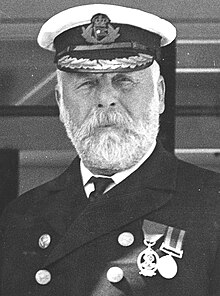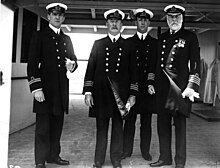Almost every movie version of the Titanic renders Captain Smith the same way. Grey-bearded and reserved, dignified, and ineffably tragic. Pictures of the real guy, in uniform, seem to confirm the impression. He had a sparkling career until the Titanic disaster. He ran his ship into an ice berg in the dead of night in calm seas. A small blemish, to be sure.


We prefer J. Bruce Ismay, President of the White Star Line, as the villain of this story. Writers and movie-makers have moved heaven and earth to make it appear as though he was responsible for the disaster, by urging the Captain to go faster. The Cameron movie version blithely sidesteps one precious little detail: the Titanic was not capable of going faster than the “crack” Cunard ships. The Titanic was built for luxury, not speed. There was no chance of it setting any records. Cameron knows that, so he merely leaves Ismay to impress upon Captain Smith that it would be nice if they could arrive a day early. At least some movie-goers, however, are easily confused, and I’ve heard people say, after seeing the movie, that it was Ismay’s fault, for trying to break “the record”.
So, we can put that to rest. Ismay may have urged speed, but the Titanic had no dreams of breaking the record.
That leaves Captain Smith. On the high seas, the Captain has absolute authority. Ismay or no Ismay, it was Smith’s decision to proceed into an area known to be inhabited by large ice bergs at the Titanic’s top speed of about 22 knots. The Titanic had received numerous warnings during the preceding days, from other other ships in the area. Smith’s precautions consisted of posting two look-outs, usual practice on White Star ships. The look-outs did not have binoculars– they had been lost before the ship even reached Cherbourg– but then, binoculars were considered an accessory, not a necessity, at the time. A good look-out was simply supposed to have good eyes.
Nobody will ever know whether the look-outs should have seen the ice berg sooner. The ocean was extremely calm, the sky was very bright. Under those conditions, ironically, ice bergs are a greater hazard, because there is almost no wash at their edges, to make them more visible. Anyway, no one knows if Frederick Fleet was really paying attention or not. We do know that he eventually saw the ice berg, signaled the bridge, and the bridge immediately ordered the engines reversed and the helm brought about. Fleet’s testimony (he survived the disaster) about how far the berg was from the ship when he first spotted it is inconsistent.
He didn’t have a happy life, by the way, after the disaster, and he committed suicide in the 1960’s.
The Titanic was poorly designed. It was a long, cigar-shaped ship, with an undersized rudder. It didn’t respond very quickly to sharp turns. It responded enough to avoid a head-on crash, but then it grazed the ice berg under the water line. The first five compartments of the ship were breeched. Within minutes, Mr. Thomas Andrews, the ship’s designer, knew that it was doomed. The rest is history.
It is here, however, that we are able to take the true measure of Captain Smith. But before we assess Captain Smith’s performance, it is worth, for comparison’s sake, taking a quick look at the actions of Captain Arthur Rostron, of the Carpathia, the ship that picked up the survivors of the Titanic disaster.
Captain Rostron received word of the Titanic disaster around midnight, long before the Titanic sunk. He immediately issued numerous orders. First, to the engine room, to stoke up the boilers and get under way immediately in the direction of the Titanic. Secondly, to the stewards, to roust blankets and supplies. Thirdly, to his officers, to ensure space for the survivors, and calm aboard his own ship, and to prepare for receiving the lifeboats. Fourth, to the wireless operator, to signal Titanic that they were under way. He followed up on his orders to see that they were carried out efficiently. The Carpathia steamed towards the disaster site at full speed, well-prepared to deal with whatever awaited it.
Onboard the Titanic, it was a different story. Smith seemed bewildered, lost, inadequate. His officers came up to him one at a time and asked permission to send flares, prepare the life boats, roust the passengers. He seemed to have no particular views on what should be done. According to testimony at both the British and American inquiries, he generally seemed to nod his head and go, “yes, yes, good idea.”
What should he have done? He should have immediately summoned all of his officers and staff. He should have emphatically specified that each life-boat was to be filled to capacity. He should have dispatched stewards to the third class compartments to arrange for the women and children to reach the boat deck. He should have instructed the officers to ensure that at least four men with some ability or experience were dispatched to each life boat. He should have declared the bar open with free drinks for all the men. Well, just kidding. Maybe. You see, at least one drunk survived a few hours in the sea, probably because the alcohol had thinned his blood.
If he had taken decisive steps, at least 500 more people could have survived the disaster. As it was, only 705 survived out of 2200. The official capacity of the 16 lifeboats was 65 each, or 1040 total. In addition, there were four “collapsible” boats, with a capacity of 24 each, making 96, or 1136 total. With calm seas– and the seas were calm– and a some ingenuity, they could easily have squeezed in an additional 100 above that.
So why do directors and writers continue to portray him as something of a hero? One reason and one reason alone: he went down with his ship, like all good captains do. Going down with the ship is the Captain’s way of saying “Ooops. I made a mistake. I’m really very sorry.” A captain who survives is basically saying, like Ismay, “What? I suppose you’re going to blame me for this?”
We are always willing to forgive those who say I’m sorry. But we also have this blather, from passenger Roger Williams Daniel:
“I saw Captain Smith on the bridge. My eyes seemingly clung to him. The deck from which I had leapt was immersed. The water had risen slowly, and was now to the floor of the bridge. Then it was to Captain Smith’s waist. I saw him no more. He died a hero.”
He died a what?
I think what Daniel is actually saying is, “having contributed nothing in a moment of great crisis, he made up for it by at least not taking up space in a half-filled lifeboat that wasn’t lowered until it was almost too late.”
